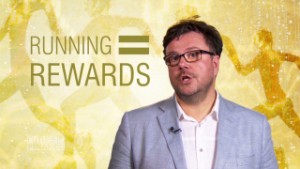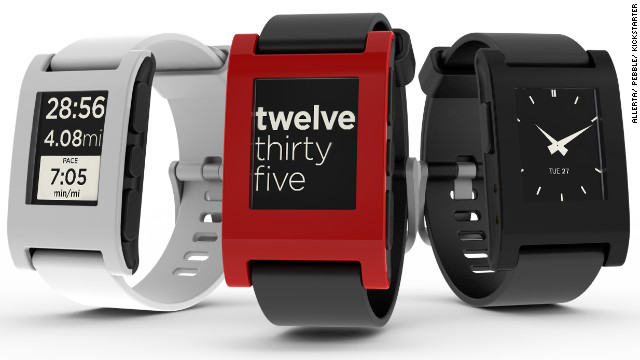Here's how to make $8 million on Kickstarter
Future Finance showcases future trends related to the global financial system.
(CNN) -- Just $50,000. That was the humble fundraising goal Ryan Grepper set on July 8, lowering his expectations for the second Kickstarter campaign for his Coolest Cooler
creation, a high-tech cooler jam-packed with all sorts of fun gizmos --
from a built-in ice crushing blender to Bluetooth speakers and a USB
charger.
See, the first time Grepper
took to the crowdfunding site -- back in November 2013 -- his goal was
far more ambitious: $125,000. Yet, after an encouraging strong start,
interest in the campaign began wavering. By closing, the project managed
to raise a little over $100,000 in pledges and eventually failed to hit
its mark.
The failure dealt a blow
to Grepper's confidence -- but the entrepreneur, who describes himself
as "part visionary, part mad scientist" refused to give up. Taking the
lessons he'd learned from the failed campaign, Grepper re-grouped and
last month re-introduced an advanced version of his creation.
 Would you bank with Starbucks?
Would you bank with Starbucks?
The result?
Just over a month later:
more than $8.2 million in pledges and some 41,000 backers. With 21 days
still to go, Grepper's project has become the third most-funded campaign
on Kickstarter ever -- and could very well hit the top spot if pledges
continue to pile in.
So, what was the secret
behind Grepper's astonishing comeback? And what are the best tips that
could help turn your business idea into a crowdfunding mega-success? To
find out, CNN's Future Finance spoke to Grepper himself and Julie Wood from Kickstarter, as well as crowdfunding experts Piers Duruz and Salvador Briggman about their top tips for being a Kickstarter success.

Ryan Grepper
Ryan Grepper, Coolest Cooler creator
Make sure the design is visually compelling.
My first Kickstarter campaign failed and I believe one of the biggest
reasons was that I had not advanced the design far enough to capture the
Kickstarter audience.
Kickstarter is a very
visual platform. When I took my design further along in the process I
was better able to share my love of the Coolest and more people
naturally connected.
Consider the time of year when customers will be most receptive.
I originally launched the Coolest in November. At the time I was
thinking we might hit the Christmas shopping and tailgating audience,
but what quickly became apparent was that folks were not focused on
coolers in November. Relaunching in July was perfect because people are
thinking about coolers during the summer and it was much easier to get
exposure. This sounds obvious now, but I believe in learning from my
mistakes.
Develop a following before the campaign.
Although my first campaign failed, I saw that some people were very
interested in the Coolest. We nurtured that interest in between our
first and second campaign and worked hard to grow that excitement. By
the time we launched our second campaign we had a terrific core of
interested backers. Now I can't believe how our group of backers has
grown.
The power of crowdfunding
More and more budding entrepreneurs and even established businesses are turning to crowdfunding platforms in the hope of raising funds for their aspiring ideas -- Kickstarter alone has attracted more than 6.7 million people pledging over $1.2 billion since its launch in 2009. Yet, it's worth remembering that 89,851 Kickstarter projects out of a total 156,781 failed to reach their funding goals.
More and more budding entrepreneurs and even established businesses are turning to crowdfunding platforms in the hope of raising funds for their aspiring ideas -- Kickstarter alone has attracted more than 6.7 million people pledging over $1.2 billion since its launch in 2009. Yet, it's worth remembering that 89,851 Kickstarter projects out of a total 156,781 failed to reach their funding goals.
Julie Wood, Kickstarter spokesperson
Make a video!
Projects with videos have a higher success rate than those without.
Your video doesn't have to be super pro looking. Some of our favorite
project videos have a very DIY feel.
Offer great rewards!
Some rewards are straightforward, like a copy of the album you made.
Other rewards are more creative and unique. The best projects tend to
have a mix of both -- it's important to have great rewards at at all
pledge levels. The most popular pledge amount on Kickstarter is $25, and
the site-wide average for all pledges is about $70.
Updates are a great way to build a relationship with your backer community.
While your project is live, keep your backers informed about new
developments and funding milestones. It'll inspire them to help you
spread the word. Treat your project like a story that's unfolding before
their eyes. Detailed updates like "Pics from last night's show!" or "We
found a printer for our book!" are fun for everybody to follow along
with.
Piers Duruz, founder of Crowdfunding Dojo
Start building an email and social media audience immediately,
with the promise of content that interests them for following you.
Growing an audience takes time, but you can do it while you plan
everything else. Even your journey to prepare can be interesting to the
right people.
The first 48 hours of your campaign is the most critical. If you can get your followers to visit and pledge at any time, make it right at the start.
Start your promotion with the people who are closest to you and
work your way out. Each group provides social proof to the next group,
by showing other people have already backed you when they arrive.
 Businesses braced for cyber attack battle
Businesses braced for cyber attack battle
Salvador Briggman, founder of CrowdCrux
Don't re-invent the wheel.
Study the creators that have come before you. How did they structure
their Kickstarter page? What rewards did they offer? How many updates
did they do throughout the campaign?
In addition, by backing
several popular projects in your category, you can see how other
creators do backer communication and how long it takes them to fulfil
their promises. Also, by browsing their list of backers, you can get an
idea of whether the supporters are part of the Kickstarter community
(backed multiple projects) or are first-time supporters, meaning the
project drove a lot of its own traffic.
Focus on emotion, but back it up with technical ability.
It's no secret that part of what makes crowdfunding campaigns spread
quickly and gather a supporter base is social media. Whether it's
networks like Facebook, Twitter, LinkedIn, and Pinterest ,or social
bookmarking websites like Reddit, StumbleUpon, Digg, Blogs, and Tumblr,
information can disseminate in a matter of hours and light up the web
2.0 news networks.
Salvador Briggman's conclusion
You might have a full-time job and be working on your art, music, or film on the side. It's difficult to maintain these passion projects and push them forward over the course of the year. Kickstarter and other crowdfunding projects condense six months' worth of focus and determination into a short 30-60 day period.
In this period, you will need to learn a handful of new skill sets and you'll get a crash course in marketing, PR, video creation, and copywriting. It's not for everyone, but if you're serious about your passion project, it's a great way to not only get financing, but also grow your professional skills, which will continue to pay dividends in the years ahead.
You might have a full-time job and be working on your art, music, or film on the side. It's difficult to maintain these passion projects and push them forward over the course of the year. Kickstarter and other crowdfunding projects condense six months' worth of focus and determination into a short 30-60 day period.
In this period, you will need to learn a handful of new skill sets and you'll get a crash course in marketing, PR, video creation, and copywriting. It's not for everyone, but if you're serious about your passion project, it's a great way to not only get financing, but also grow your professional skills, which will continue to pay dividends in the years ahead.
What many people
overlook is the reason why information spreads: it spreads when it makes
a reader feel a certain way, which then makes them want to share that
link.
The feeling that prompts
a backer to share that link could be "This is so cool!" or "This is an
important cause." It's easiest to invoke a feeling when you have a prior
relationship with your backers, as is the case with the multi-million
dollar "Reading Rainbow" campaign.
Although ultimately, you
want your backers to come away from your video and campaign feeling
something, you must also back up your pitch with technical ability. What
prototype have you created? Why can your team deliver on their
promises? You must engage both the left and right hemisphere of the
brain when crowdfunding.
Everything is sales.
Typically, when we think of a salesman, we think of a slimy
quick-talking city slicker with too-white teeth and a $2,000 suit. These
types of individuals are an instant turnoff.
The best types of
salesmen don't make you feel like you are being "sold to." They have the
ability to create the urge to buy. Usually this is the result of giving
people what they want, or connecting problems people experience with an
appropriate solution.
Since you are going to
be doing a lot of self-promoting, it's important that you adopt the
mental mindset of your potential backers. What types of rewards would
get them excited? How would they want to be pitched? What would turn
them off?


 Pebble: E-Paper Watch for iPhone and Android: $10.3 million pledged of $100,000 goal, 68,929 backers
-- Pebble is a minimalist watch that displays texts and emails,
vibrates for each call and controls music playlists, among other
features.
Pebble: E-Paper Watch for iPhone and Android: $10.3 million pledged of $100,000 goal, 68,929 backers
-- Pebble is a minimalist watch that displays texts and emails,
vibrates for each call and controls music playlists, among other
features.








0 comments:
Post a Comment